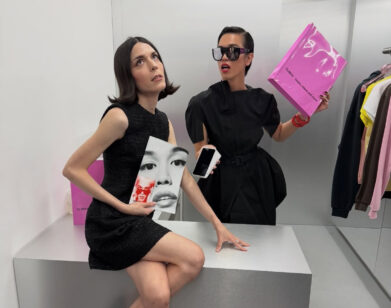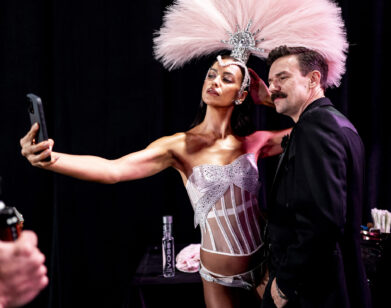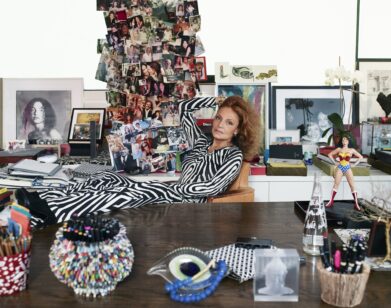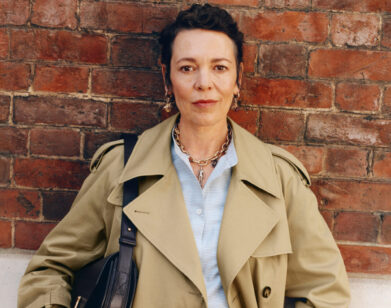The Art of ADEAM
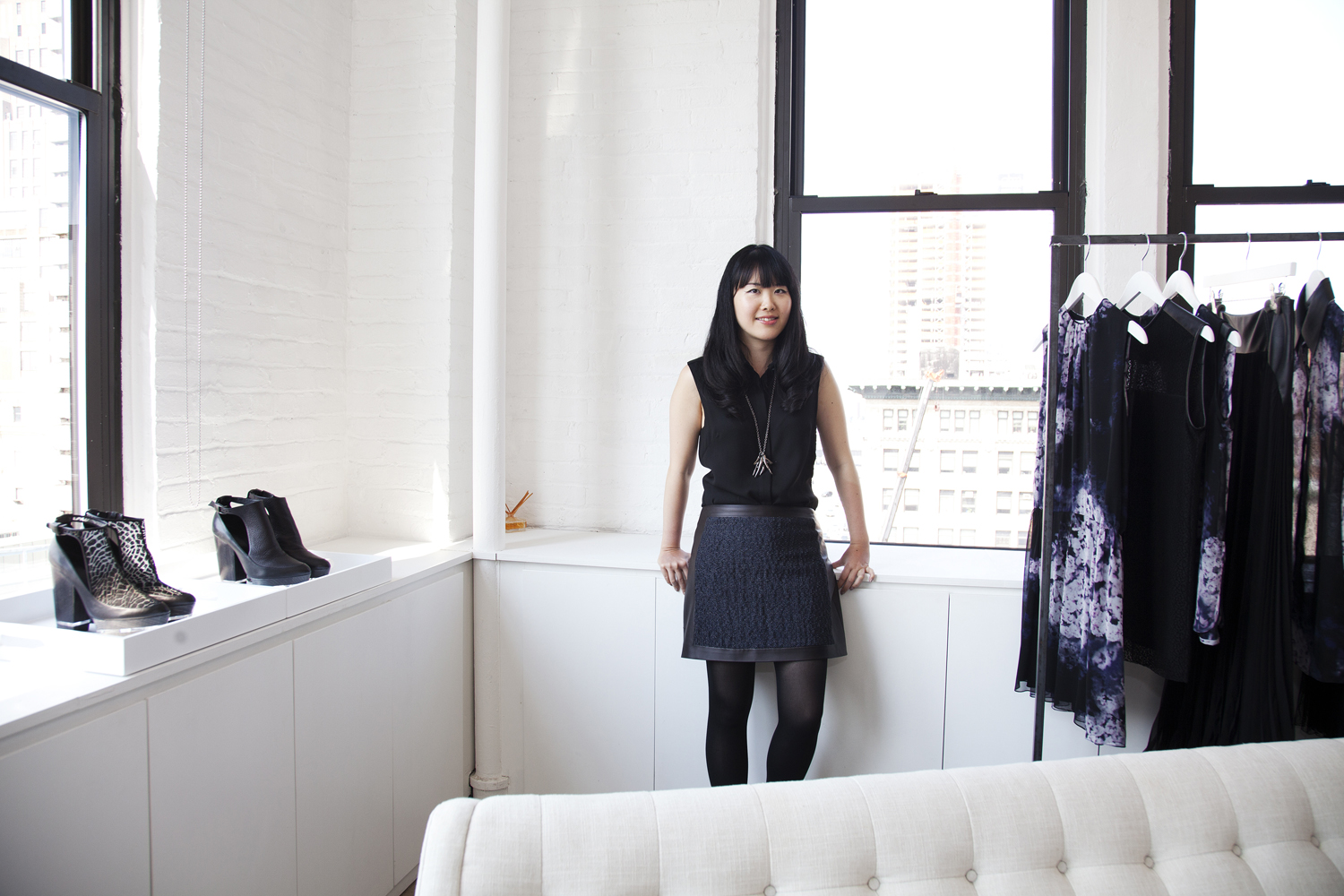

Designers too often sacrifice wearability in favor of making a piece beautiful. This is not the case with ADEAM, the two-year-old label from Hanako Maeda, which expertly does both. Maeda’s clothes possess precise tailoring superimposed with artistic details for an easy transition from daily life to fantasy fashion spread. It’s an aesthetic envisioned for the New York working woman–someone whose lifestyle demands that her attire be practical, but who is never inclined to settle for the ordinary.
Born in Tokyo, where her parents run ready-to-wear line Foxey, Maeda moved to New York to attend high school and went on to major in art history at Columbia University. She eventually landed a fashion internship at Vogue, where she was able to observe firsthand the thought process behind fashion editorials—a facet of the industry that’s always ignited her imagination. A later internship at Phillip Lim 3.1 helped solidify her aspiration to design. “Looking at all these people believing in one person’s vision really inspired me,” she reflects. “It felt special to be in that kind of atmosphere.”
Mingling nature imagery and fine arts references, Maeda–which is ADEAM backwards–infuses the clothes with New York functionality and Japanese culture. In the 2013 resort collection, a painterly cherry-blossom print recalling Japan in springtime is set on a wispy, sweeping maxi-dress, while structured jackets are in sensible monochromes. The debut collection, which showed in Tokyo during the Spring/Summer 2013 season, appropriated the wave motif from the Japanese woodblock print “The Great Wave of Kanagawa” by Katsushika Hokusai. Her next Spring/Summer collection, showing tomorrow at New York Fashion Week, is about embracing dualities. With a nod to the soft colors of abstract artist Agnes Martin, Maeda’s inspiration is pastel-colored summer hydrangeas under a gloomy Tokyo sky.
We sat down with Maeda at her favorite tea spot in the West Village to talk about her passions, problems with perfection, and the exquisite female form.
RACHEL SMALL: What first piqued your interest in visual art and fashion?
HANAKO MAEDA: I took art history in in high school, which was great because we were right across from the Metropolitan Museum of Art. My high school had this program where you could intern the last month of your senior year, and I interned at Allure. Even though Allure is a beauty magazine, they have a great fashion department. Working in the closet was my first exposure to the fashion industry. I also went to a program at Columbia Journalism School, where I learned how to design layouts, and things like that. I got the best layout award. Small things like that, as like a 17, 18-year old, mean a lot. I was like, “Oh, my God, I really want to go into fashion editorial.” So when I went to college, I majored in art history at Columbia, and I interned at Vogue.
SMALL: What did you learn there?
MAEDA: There’s actually an intellectual process behind fashion editorial, and how the editors style. There’s lot of background research on the history behind the era that they’re covering. I think fashion, to a lot of people, seems really superficial and not very intellectual, but when you look at all these people that work in the industry, they have a really philosophical thought process behind what they put out.
SMALL: Then you interned in PR at Phillip Lim 3.1. What was that like?
MAEDA: Every single department, whether it’s design or PR or marketing, all work together. I felt it was special and precious to have a really strong team that works towards one goal. I guess that’s how I got into fashion design. I’ve always loved sketching, so it was more of a natural, organic profession for me.
SMALL: You’ve obviously had many different visual interests over the years. How have those gone into your initially conceiving ADEAM?
MAEDA: I think about a few things when I’m designing my collection: one is balancing creativity, functionality, and wearability. There is an artistic component to fashion, but at the end of the day, it has to feel good and look good on a woman’s body. Also, coming from a fine-arts background, I want to incorporate something external to fashion in my designs. I draw on inspiration from art, literature, or music. I feel like that makes it more interesting. I’m also a huge feminist, and as a female designer I feel like it’s important to empower women through my designs. I think it’s important for clothing to be flattering and make women feel beautiful, but I don’t think that means you have to feel uncomfortable in what you’re wearing.
SMALL: I liked the Japanese cherry-blossom inspired prints in your resort collection–and I liked that they were printed on clothes that could work for a New York career woman. You’ve also split a lot of your life between Japan and Tokyo. Would you say these dual Japanese and New York influences play out often in your collections?
MAEDA: I’m think my aesthetic is definitely influenced by the fact that I’ve spent most of my life in the two cities. I love how Tokyo’s fashion is like so spontaneous and avant-garde—it pushes me to be original. In New York fashion, there’s such a close proximity between runway and street style. I feel like the women I see on the streets are so chic. They know what feels comfortable and what looks good on them. Combining the two makes my clothing more relevant for the modern woman.
SMALL: What’s some surprising feedback you’ve received? Or comments that have made you see your own work in a new light?
MAEDA: It’s actually really interesting. In Japan, all the editors are like, “Oh, I can really see how moving your studio to New York has influenced your aesthetic,” and “We can really see how New York style is influencing you.” Here in New York, a lot of editors have mentioned that they can see my Japanese background and Japanese influences. I guess if you’re coming from another point of view, it looks really different.
SMALL: You draw a lot on the natural world for inspiration.
MAEDA: Yeah. I didn’t realize it until recently, but every season there’s some part of my inspiration that’s from nature. So in Fall 2013 it was a forest theme inspired by Into the Wild, and for resort 2013 it was cherry blossoms. I think it comes from the fact that I like organic things—I think there is beauty in imperfection, and everything in this world that is organic is imperfect. All living things are not perfect and that’s why they’re beautiful. There’s no point in striving for perfection, because it’s more natural. It’s more beautiful when something is not touched by the human hand or organized to the point that it is really perfect on the street. Honestly, I would be bored if every single person looked the same.
SMALL: [laughs] Right. Which artist, living or dead, would you want to collaborate with?
MAEDA: That’s really hard. Well, for this spring actually, a part of my inspiration was Agnes Martin. She’s a little tricky, because she’s technically a minimalist, but she herself didn’t consider herself as a minimalist. So, for spring I’m doing a lot of ashy pastels, and a lot of those colors were pulled from her work.
SMALL: You make a lot of things that could come off like basics, but if you look closer you always add flares of creativity. How do you come up with those?
MAEDA: I’m drawn to something with a classic silhouette that has like a twist. I’d think about a classic item, like a white shirt or a romper (which is more of a childhood nostalgic item), and elevate it to a more high-fashion piece. For spring I’m doing something inspired by cut-off jean shorts with pockets peeking; I made these shorts with oversized organza pockets. So I try to take everyday, mundane items and then elevate that into high fashion.
SMALL: How do you express your vision to your team?
MAEDA: Initially I make a mood board. I’ll compile all these images and little fabric swatches and things like that. It usually comes from a trip that I took or a book that I’ve read, or an exhibition that I went to. It’s usually something I’ve experienced in the near past. Also, I show everyone my sketches to show them the direction for the season.
SMALL: What’s been the most rewarding part so far?
MAEDA: Knowing that there are so many people who support my line is really amazing. We’ve had great responses from editors and buyers as well. That kind of support early on is really important.
SMALL: How are you going to keep consistent what ADEAM represents?
MAEDA: Believing in your vision. There’s a lot of talk, especially in editorial, about who is relevant and who is not. I look to someone like [Azzedine] Alaïa, who’s done the same thing for 30 years. I believe sticking to what you love doing is really important as a designer. I feel like everything follows.
SMALL: What’s your favorite part about designing clothes, as an art?
MAEDA: I think the female body is one of the most beautiful things in the world. That’s really inspiring for me. And fashion is the only art that you wear on your body. Having that intimate connection with the viewer, or the customer, is really amazing.
SMALL: What’s the most important thing that people know about ADEAM?
MAEDA: I have all of these ideas behind it, but I don’t necessarily feel that everyone needs to understand that as long as they look at it and they think that it looks beautiful, and it also makes them feel beautiful when they put it on. My inspiration and my beliefs are really important to me, but when it comes to the clothes I want them to speak for themselves.
ADEAM IS SHOWING TOMORROW FROM 1:30 TO 2:30 PM AT LINCOLN CENTER IN NEW YORK.



